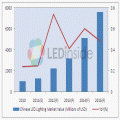2013-07-09
In view of the perspective of semiconductor lighting application, people are unanimously optimistic about the development of LED industry in middle and long term, the penetration of LED in lighting market will continue to rise, it is likely to exceed 50% in 2016, even it may be more than 70 % after 2020 with further growth. Energy conservation and technology economy will become two important drivers of this trend. Currently, higher cost is still the obstruction for large-scale promotion of semiconductor lighting products, but the prices of LED has been steadily falling, accord...
Continue reading →
2013-07-09
Recently, REFOND said that the recent capacity expansion has eased its capacity bottlenecks, while in the case that backlight procurement is transferring and demand in lighting market is accelerating, the expansion will be helpful for the company to realize earnings growth in future. In the short term, it becomes more possible for REFOND to achieve great revenue growth in the second half of this year. Bank of China International (BOCI) stated that REFOND will achieve continued growth in the coming years for full benefit from the growth in lighting demand. RE...
Continue reading →
2012-05-21
As we know, Chinese standing committee of state council passed the basic public service system planning on 12th Five-Year and scheduled to arrange for 2.2 billion yuan RMB to promote energy-saving lamps and LED lights on May 16. After the release of the statement, LED manufacturers are curious about the number of lights relating to the promotion. And deputy secretary-general ZhaoJiaRong , from the national development and reform commission, pointed out that ,” there are two measures to put into practice. One is to gradually implement the Incandescent Bulb Phas...
Continue reading →
 2011-11-10
2011-11-10
The Chinese government recently announced a time frame for the phasing-out of incandescent lamps. China will ban imports and sales of 100W and higher incandescent bulbs starting from October 1, 2012, and ban on 60W and higher incandescent bulbs starting October 1, 2014. October 1, 2015 to September 30, 2016 will serve as an evaluation period. Starting on October 1, 2016 the ban will be extended to 15W and higher bulbs, or adjusted according to the results of the evaluation. The policy is expected to save 48 billion kilowatt hours of power per year and reduce carbon dioxide emissions by 48 million tons annually.
Continue reading →
 2011-11-10
2011-11-10